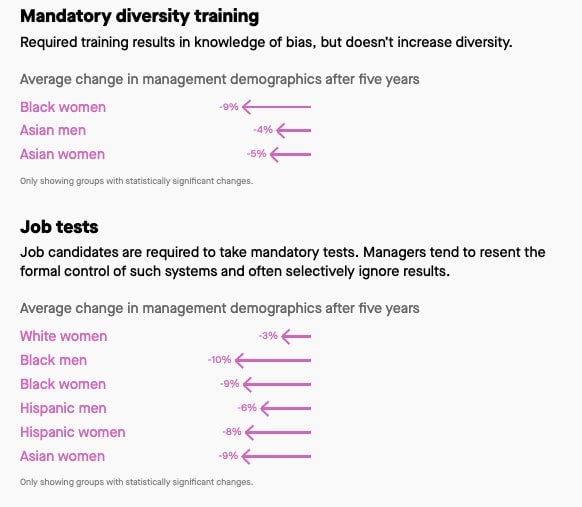Some common diversity initiatives actually decrease diversity, data show
Employees at about half of mid-size American companies, and nearly all Fortune 500 firms, participate in some form of mandatory diversity training. It’s a shame it doesn’t work.


Employees at about half of mid-size American companies, and nearly all Fortune 500 firms, participate in some form of mandatory diversity training. It’s a shame it doesn’t work.
In fact, mandatory diversity training, grievance procedures, and job tests—three of the most common diversity and inclusion initiatives employed by companies—produce results contrary to their stated goal.
That’s according to a series of studies by academics Alexandra Kalev and Frank Dobbin on diversity and inclusion initiatives. They analyzed the effect of such programs on manager diversity at 829 US companies over three decades. Today, it’s still the largest study of its kind.
“Nobody else has done what we’ve done, which is to look at a bunch of practices and just say what works to change the numbers in a firm; what works to actually increase diversity and inclusion,” explains Dobbin.
The difference between initiatives that work, and those that don’t, often comes down to responsibility. Managers need to think of increasing diversity as part of their job.
Programs that don’t work are those that often leave people with negative feelings and those that take away managers’ agency.
Dobbin was particularly disappointed to see that grievance systems are actually harmful to diversity efforts. “Normally it’s not the manager you complain about that leaves, it’s you,” said Dobbin. “Our data suggest that companies with these systems in place retaliate against whole groups of people. I just find that devastating.”
Often, companies persist with ineffective initiatives because many don’t realize they are not working. For others, training seems like an easy solution.
“You don’t have to change anything about the organization. You can just hire someone to come in and do it.” Despite its inefficacy, training has become a de facto requirement. “If you don’t do it,” Dobbin says, ”people ask you why you don’t,” because so many other companies do.
People just don’t know a lot about other options.
Dobbin says the first step towards effective diversity and inclusion programs is establishing a task force. “Get them to start thinking about how to solve the problem by looking at the data,” he advises. Only 20% of the companies he and Kalev studied had task forces. “Companies have very good HR information systems now, so mostly they can track what the problem is…A task force can look at the data and try to figure out where the problems are, and try to brainstorm solutions.”
Of course, that’s if management is even willing to acknowledge something needs to change. “It’s still mostly white men that are in the decision-making positions. A lot of those men think there isn’t anything wrong with their firm. And I think that’s one of the biggest obstacles that companies face.”